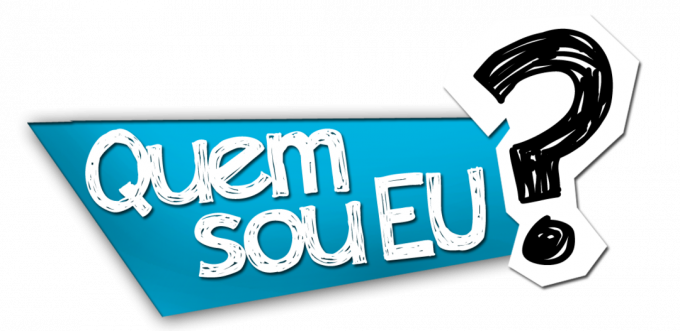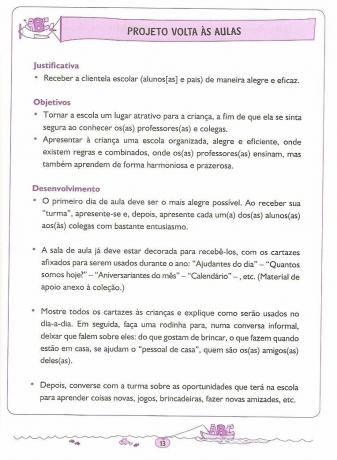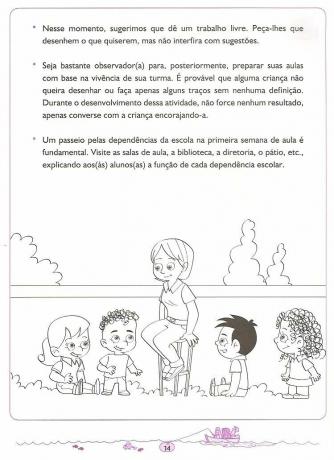
We selected in this post some suggestions for Project back to school early childhood education to work in the first weeks of school. Wonderful suggestions and ready tips for working with early childhood education students.
See also:
Index

This project was conceived because it felt the need to provide students with a broader knowledge of themselves, of the various nuances of the human being, with a focus on the areas cognitive, socio-affective and bodily, inserted within the current socio-historical context, and also knowing the role of the school within society, students enter school without to know the reason why they are being taken to school, as parents often convey the idea that going to school to “earn” food, snacks, and also to play with other kids. We realized the need to make not only children, but also families, to realize that going to school is one of the ways to acquire or review the knowledge that each child brings with them.
Oral and Written Language: – Rounds of conversations, – Reading and writing of the name, – Parlendas, – Guesses, – Lock – language, – Stories. Mathematics: – Sequence of numbers, – Counting, – Function of numbers, – Spelling of numbers, – Reading of numbers. Arts: – Drawing, – Painting, – Cutting and collage, – Modeling, – Appreciation. Nature and society: – Body scheme, – Sense organs, – Pets. Movement: – Circuits, – Play, – Psychomotricity. Music: – Interpreting children's songs, – Listening to classical and popular music.
TEACHING GUIDELINES: – Prepare the material for the Initiation Dynamics, “Treasure”. – Provide photos of students for self-portrait activities. – Material provisions for students To draw their self-portraits. – Conduct research on the history of student names. – Collect magazines for use in class research by students. – Making research and observation material for the use of students regarding the different physical characteristics of human beings. (tall, short, fat, thin, white, black, etc.). – Research the meanings of class names. – Prepares material needed to develop the activity sequences to be worked on during the project. (attached to the project).
PHASES: – Apply the dynamic “Treasure” in a circle. – Encourage the observation of similarities and differences in the group, (eye color, hair, height, etc.). – Propose grouping according to the equalities present in the group (hair length, height, boys and girls, etc.). – Start the activity sequences in the order proposed below.
1- Self – Portrait.
2- History of the Name.
3- Activities with names.
4- Body scheme.
5- Height and weight.
6- Sense organs.
7- Shoe number.
8- Pets.
FINAL PRODUCT: Individual album and collective mural.
Also check:



Check out the wonderful suggestions below. Project back to school early childhood education, elaborated by Simone Drummond.
I also recommend:
At the beginning of the school year, the child becomes acquainted with a new space that is physical and also subjective, as it involves feelings and relationships. At this time, it is essential to favor an environment rich in stimuli, where the child can meet and live new experiences, expressing their thoughts and emotions freely. To do this, it is necessary to bear in mind that the adaptation period is delicate and requires the participation of all components of the school community: parents, teachers and other employees of the institution in which the child It's inserted.
The big challenge is to welcome the child in their first moments at school or at each new school stage, making them feel cared for, comfortable and, above all, safe. It is important to establish a relationship of trust with the families as well, making it clear that the goal is a partnership of care and education. Enabling parents to stay with the children for the first few days, allowing the children to take an object from home with which they feel safe are some interesting proposals for this welcome.
The first social relationships of the child happen in Kindergarten, therefore, it is necessary to provide, in addition to a climate of affection and mutual trust between students, parents and school employees, the psychomotor development of the child, through a playful and pleasant. The stimulation in group activities generates an atmosphere of joy that incites curiosity and finally the child's natural approach to the group.
The school must plan activities suitable for the adaptation period, not distancing themselves from what the student will experience on a daily basis, so that false expectations are not created.
Children are different, each human being is unique and each person's reactions are unpredictable. In addition, they arrive at school with acquired knowledge, experiences and experiences that cannot be overlooked. Therefore, it is necessary to vary the possibilities, plan different activities, always respecting the differences and pace of each one. When realizing that the adult considers their feelings and those of their peers, that they are valued in their fears and insecurities, the child learns to establish a more humanizing relationship with the others.
In Kindergarten, children come to understand the basics of coexistence. The school environment needs to convey safety to children in all aspects, this safety is also translated into clear rules and a well-established dialogue between educators and students. Small agreements around social coexistence norms facilitate relationships. Therefore, it is essential to define the rules together with the group, questioning them about the reasons for each one, leading them to understanding and reflection.
The space must be the result of the relationship established with the children. Its decoration, the displayed posters must reflect the inquiries, discoveries and paths of those who use it. The space still needs to be organized in order to contemplate the different human dimensions: the playful, artistic, affective, cognitive. The way the environment is organized always reveals the pedagogical relationship established between educator and students.
Goals:
After a round of conversations that will define the rules, the proposal is to set up a mural with them and illustrate it with drawings and productions by the students themselves.
Hide in the living room bags or packages containing various materials that will be part of children's daily lives. It can be, for example, books, magazines, games, brushes, modeling clay or some clay. Propose to the group that, in pairs, they look for the objects. This already encourages cooperation. Guide the search by saying “hot” if what you're looking for is close, “warm” if it's at medium distance, or “cold” when it's far away. Once all the packages are found, ask what activities can be done with the materials and take the opportunity to better explain the function of each one. Show how and where they will be stored, highlighting the importance of keeping the work environment well organized.
To end the activity, allow each child to choose their favorite object to play with or create something. After the games and creations, guide them to arrange the environment as agreed, putting everything in its proper place.
The organization of space influences users by determining how teachers and children feel, think and behave.
Where? He thought!
Time: As long as the interest of the class lasts.
Space: Classroom.
Age: From 1 year and a half.
Material: Mobiles with strips of tulle of different colors (the length of the strips must be the same as the height of the room's ceiling height).
Main Objective: To help the child to work out the temporary absence from the family.
Development: Hang the mobiles securely from the ceiling of the room so that the banners reach the floor. The children will play hide behind and between them, hold them to cover part of the body and hide their peers. With this, they discover that the absence of the other is temporary and that they always reappear.
Time: Variable according to number of students
Space: Classroom.
Age: From 2 years old
Main Objective: Provide observation of classmates, helping group integration, emphasizing respect for differences.
Development:
Tell the class that everyone will get a "picture." Tape a child-sized sheet of Kraft paper to the wall. Position the student so that he is leaning against the sheet and, with a pencil, draw the outline of his body. Encourage the class to say what your hair is, your face, if you wear glasses, etc. During the activity, repeat the student's name many times so that classmates can memorize it. Make the “picture” of everyone. Finally, ask a classmate to draw your outline, repeating the observation process, so that the children become familiar with you too. Hang the drawings on the wall and praise the group. Over the next few days, at the entrance, ask the class who each of the drawn classmates is and if he is present. If so, you get a round of applause. Leave the papers exposed for a while. It is important for the little ones that their productions stay there until they feel they belong to the group and the environment.
Time: Approximately 40 minutes.
Space: Classroom.
Age: From 1 year.
Material: Colored cloths, mirror.
Objective: Working memory, anticipation, visual and auditory perception, principles of distinction between the “I” and the “not me”.
Development:
To carry out this activity, place the children in a cozy space (on mats, for example). Conduct the show the face game and cover it with a cloth. After exploring hide-and-seek a lot, give the babies the other colored cloths so that they can imitate your action, stimulating them with words. A variation on this activity is to put the children in front of the mirror to play with their own image. This proposal is important in the first years of life because it is related to the perception of the “I”. In front of the mirror, the child begins to recognize its image and its physical characteristics.
working diversity – Ask the children to stand in front of the mirror and observe themselves. Ask; “Is your hair the same color as the guy's?”, “Where's your eyebrow?”, “Who's taller?” etc.
Facial expressions – Facing the mirror, ask the students to make a happy, sad, pained, angry face, etc. Display posters with different faces for the children to imitate.
Pretend – Provide costumes, accessories (hats, jewelry, glasses, etc.) and makeup and let children explore their self-image freely, including using the mirror as a resource.
Subscribe to our email list and receive interesting information and updates in your email inbox
Thanks for signing up.


